Microeconomics Assignment: Equilibrium Analysis of Chicken Market
VerifiedAdded on 2023/06/13
|16
|1966
|90
Homework Assignment
AI Summary
This microeconomics assignment provides a comprehensive analysis of the chicken market, covering demand and supply curves, equilibrium determination, and elasticity calculations. The assignment begins by constructing demand and supply curves based on provided data, deriving their respective equations, and identifying the market equilibrium point where demand equals supply. It further explores concepts such as excess supply, opportunity cost, and the impact of external factors like changes in the price of substitute goods (beef) and technological advancements (IT in aviculture) on the market equilibrium. The assignment also delves into elasticity of demand and supply, calculating these at specific points and analyzing their implications for total expenditure. Finally, it examines consumer and producer surplus, quantifying these measures of economic welfare in the chicken market, demonstrating an equal distribution of total surplus between consumers and producers. Desklib offers a wealth of similar solved assignments and past papers to aid students in their studies.
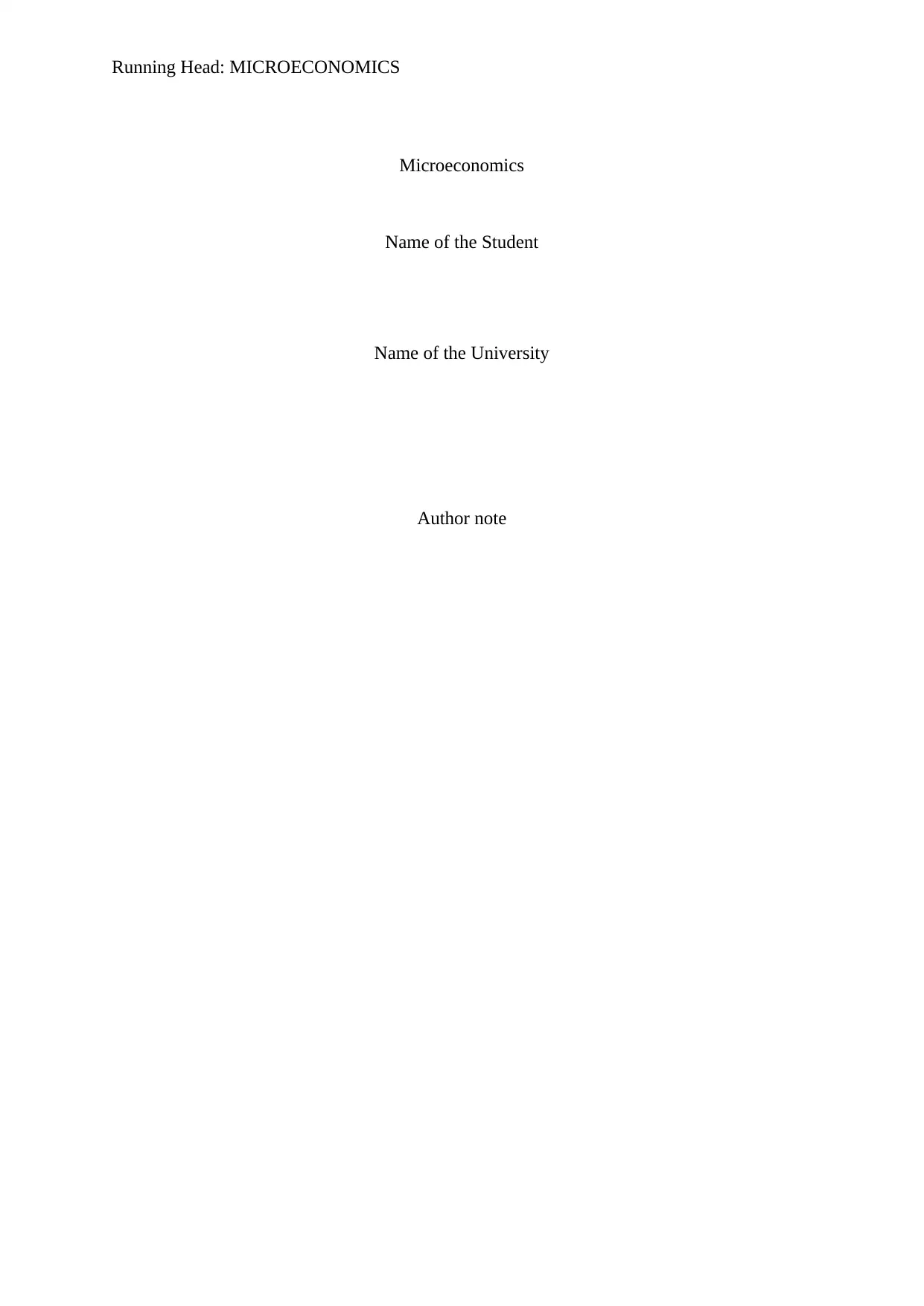
Running Head: MICROECONOMICS
Microeconomics
Name of the Student
Name of the University
Author note
Microeconomics
Name of the Student
Name of the University
Author note
Paraphrase This Document
Need a fresh take? Get an instant paraphrase of this document with our AI Paraphraser
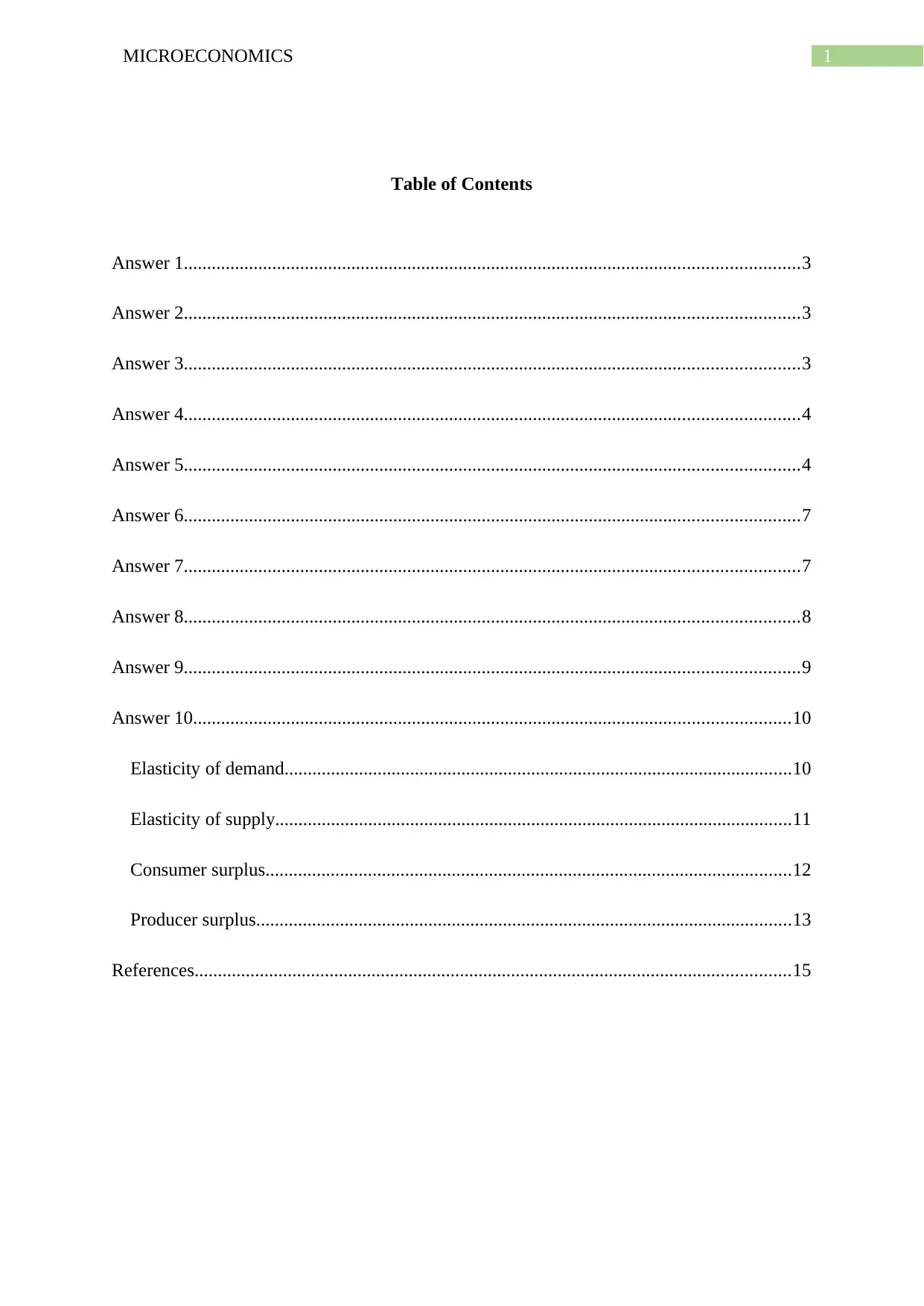
1MICROECONOMICS
Table of Contents
Answer 1....................................................................................................................................3
Answer 2....................................................................................................................................3
Answer 3....................................................................................................................................3
Answer 4....................................................................................................................................4
Answer 5....................................................................................................................................4
Answer 6....................................................................................................................................7
Answer 7....................................................................................................................................7
Answer 8....................................................................................................................................8
Answer 9....................................................................................................................................9
Answer 10................................................................................................................................10
Elasticity of demand.............................................................................................................10
Elasticity of supply...............................................................................................................11
Consumer surplus.................................................................................................................12
Producer surplus...................................................................................................................13
References................................................................................................................................15
Table of Contents
Answer 1....................................................................................................................................3
Answer 2....................................................................................................................................3
Answer 3....................................................................................................................................3
Answer 4....................................................................................................................................4
Answer 5....................................................................................................................................4
Answer 6....................................................................................................................................7
Answer 7....................................................................................................................................7
Answer 8....................................................................................................................................8
Answer 9....................................................................................................................................9
Answer 10................................................................................................................................10
Elasticity of demand.............................................................................................................10
Elasticity of supply...............................................................................................................11
Consumer surplus.................................................................................................................12
Producer surplus...................................................................................................................13
References................................................................................................................................15
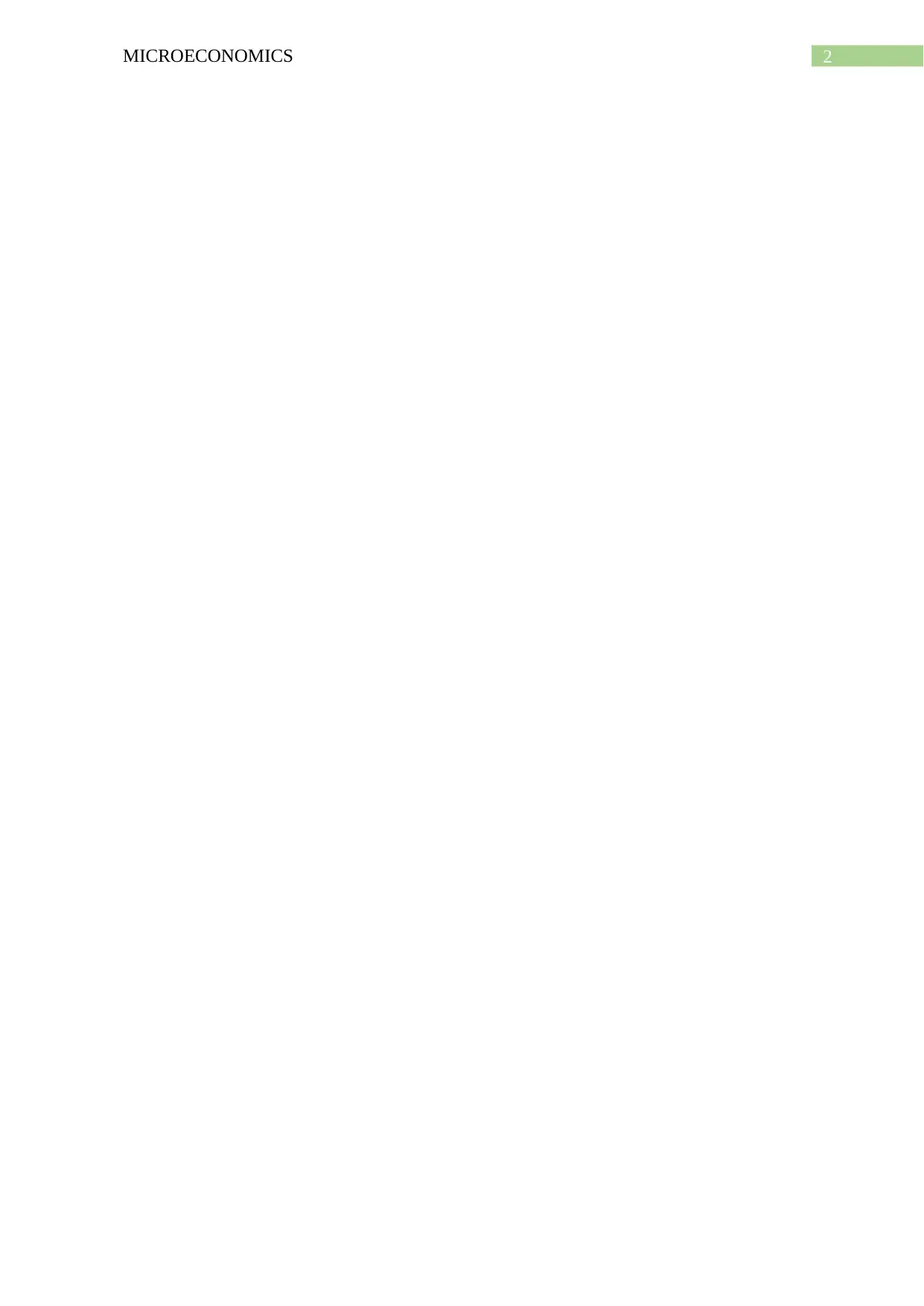
2MICROECONOMICS
⊘ This is a preview!⊘
Do you want full access?
Subscribe today to unlock all pages.

Trusted by 1+ million students worldwide
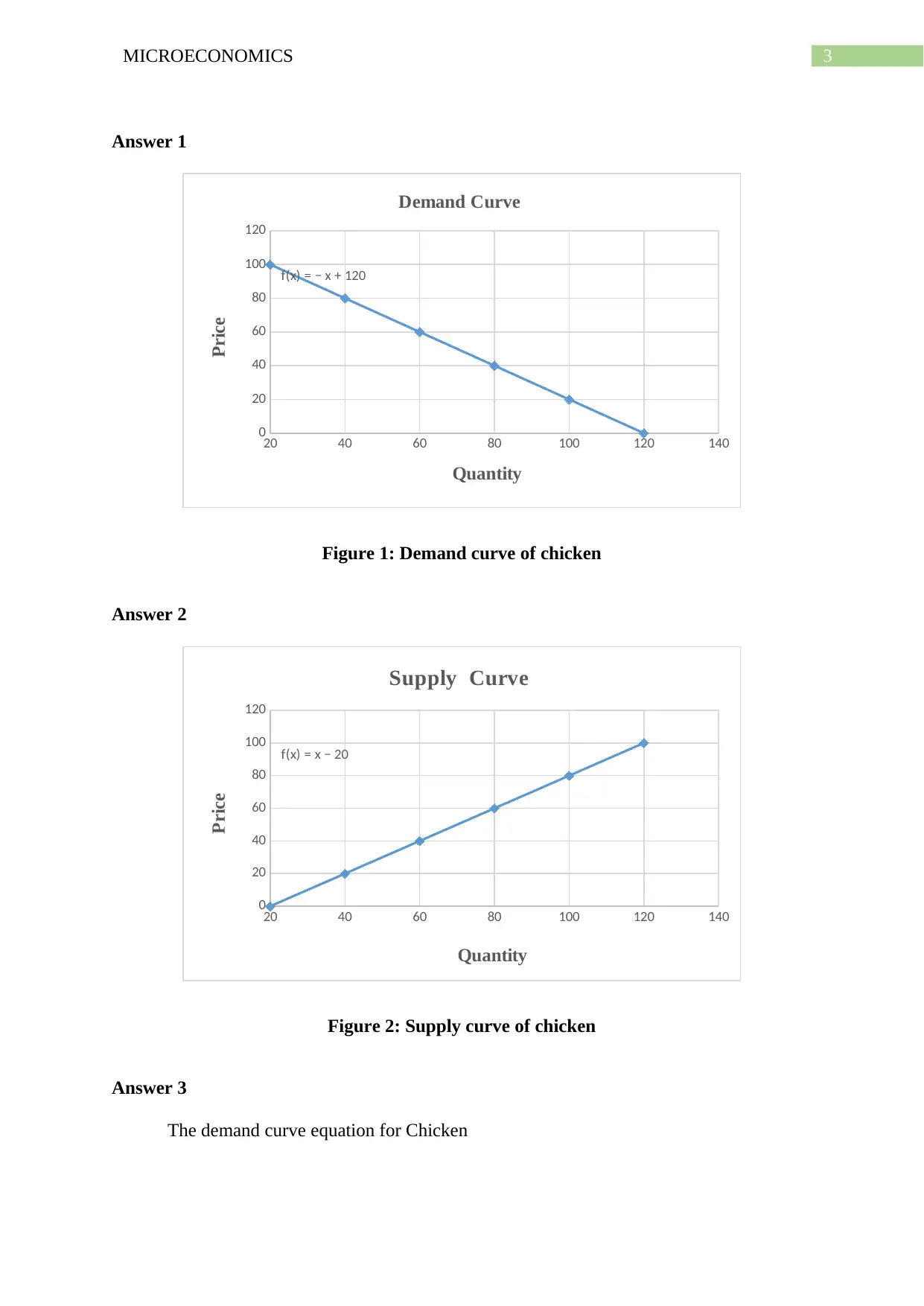
3MICROECONOMICS
Answer 1
20 40 60 80 100 120 140
0
20
40
60
80
100
120
f(x) = − x + 120
Demand Curve
Quantity
Price
Figure 1: Demand curve of chicken
Answer 2
20 40 60 80 100 120 140
0
20
40
60
80
100
120
f(x) = x − 20
Supply Curve
Quantity
Price
Figure 2: Supply curve of chicken
Answer 3
The demand curve equation for Chicken
Answer 1
20 40 60 80 100 120 140
0
20
40
60
80
100
120
f(x) = − x + 120
Demand Curve
Quantity
Price
Figure 1: Demand curve of chicken
Answer 2
20 40 60 80 100 120 140
0
20
40
60
80
100
120
f(x) = x − 20
Supply Curve
Quantity
Price
Figure 2: Supply curve of chicken
Answer 3
The demand curve equation for Chicken
Paraphrase This Document
Need a fresh take? Get an instant paraphrase of this document with our AI Paraphraser
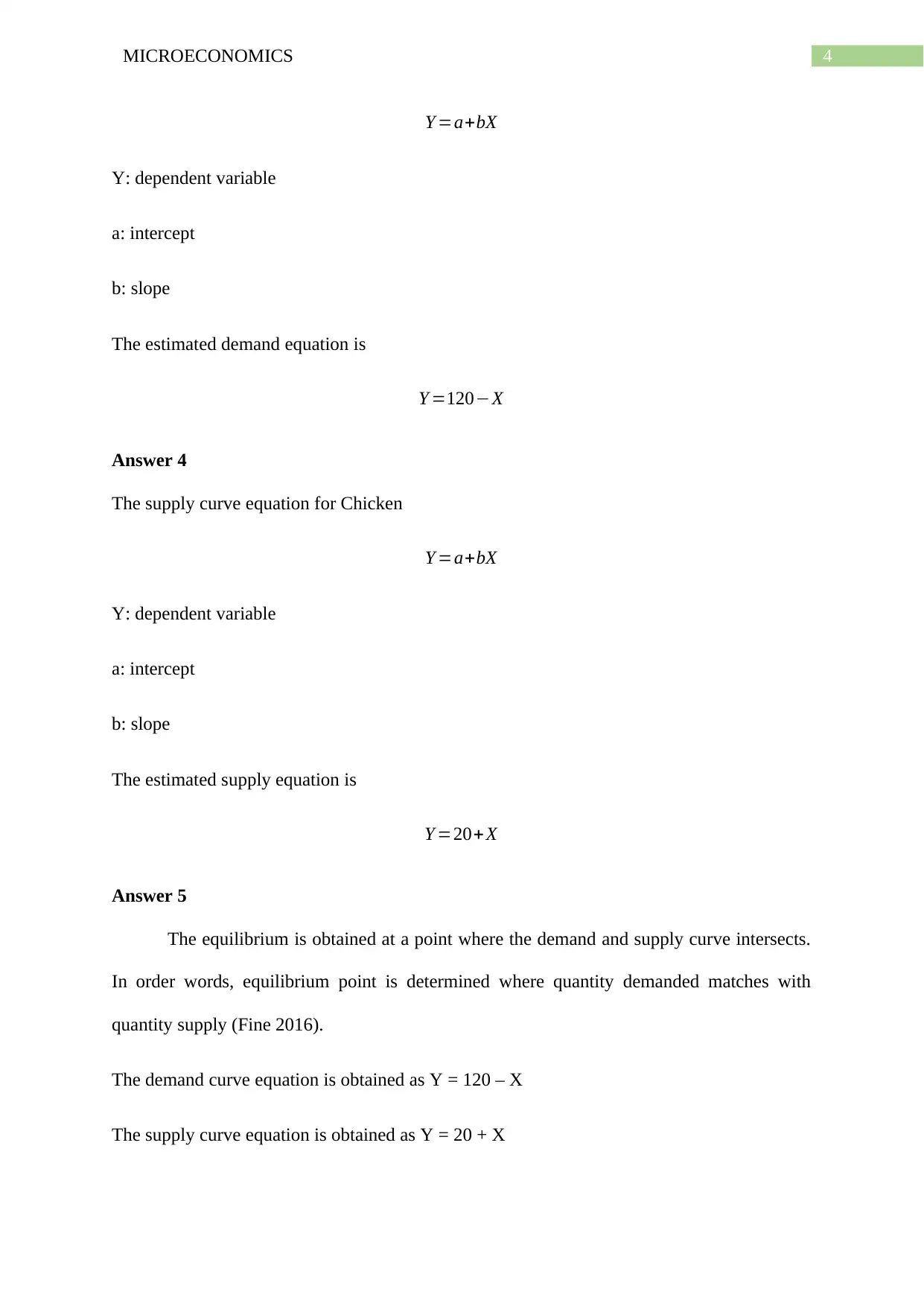
4MICROECONOMICS
Y =a+bX
Y: dependent variable
a: intercept
b: slope
The estimated demand equation is
Y =120−X
Answer 4
The supply curve equation for Chicken
Y =a+bX
Y: dependent variable
a: intercept
b: slope
The estimated supply equation is
Y =20+ X
Answer 5
The equilibrium is obtained at a point where the demand and supply curve intersects.
In order words, equilibrium point is determined where quantity demanded matches with
quantity supply (Fine 2016).
The demand curve equation is obtained as Y = 120 – X
The supply curve equation is obtained as Y = 20 + X
Y =a+bX
Y: dependent variable
a: intercept
b: slope
The estimated demand equation is
Y =120−X
Answer 4
The supply curve equation for Chicken
Y =a+bX
Y: dependent variable
a: intercept
b: slope
The estimated supply equation is
Y =20+ X
Answer 5
The equilibrium is obtained at a point where the demand and supply curve intersects.
In order words, equilibrium point is determined where quantity demanded matches with
quantity supply (Fine 2016).
The demand curve equation is obtained as Y = 120 – X
The supply curve equation is obtained as Y = 20 + X
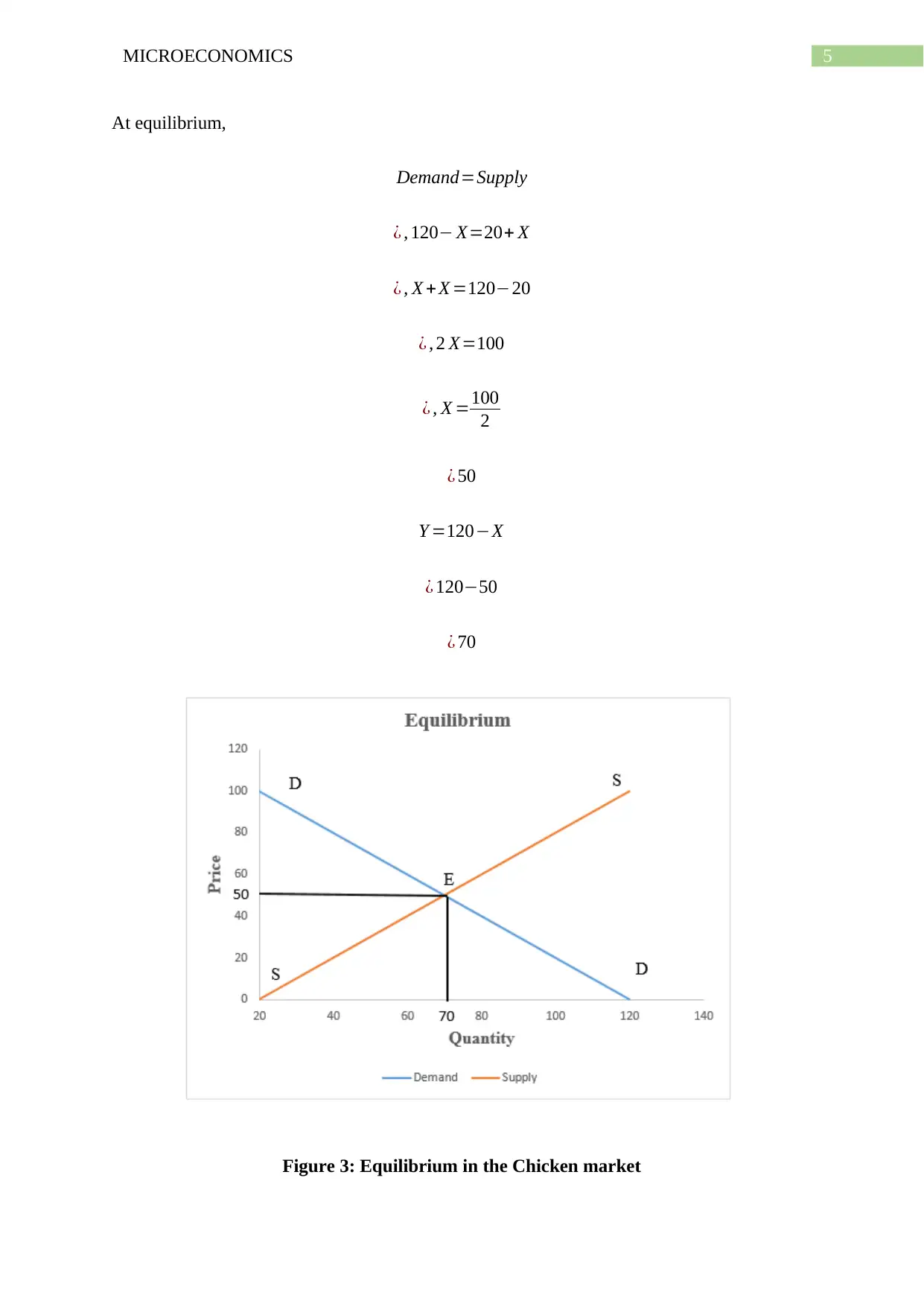
5MICROECONOMICS
At equilibrium,
Demand=Supply
¿ , 120− X=20+ X
¿ , X + X =120−20
¿ , 2 X=100
¿ , X =100
2
¿ 50
Y =120−X
¿ 120−50
¿ 70
Figure 3: Equilibrium in the Chicken market
At equilibrium,
Demand=Supply
¿ , 120− X=20+ X
¿ , X + X =120−20
¿ , 2 X=100
¿ , X =100
2
¿ 50
Y =120−X
¿ 120−50
¿ 70
Figure 3: Equilibrium in the Chicken market
⊘ This is a preview!⊘
Do you want full access?
Subscribe today to unlock all pages.

Trusted by 1+ million students worldwide
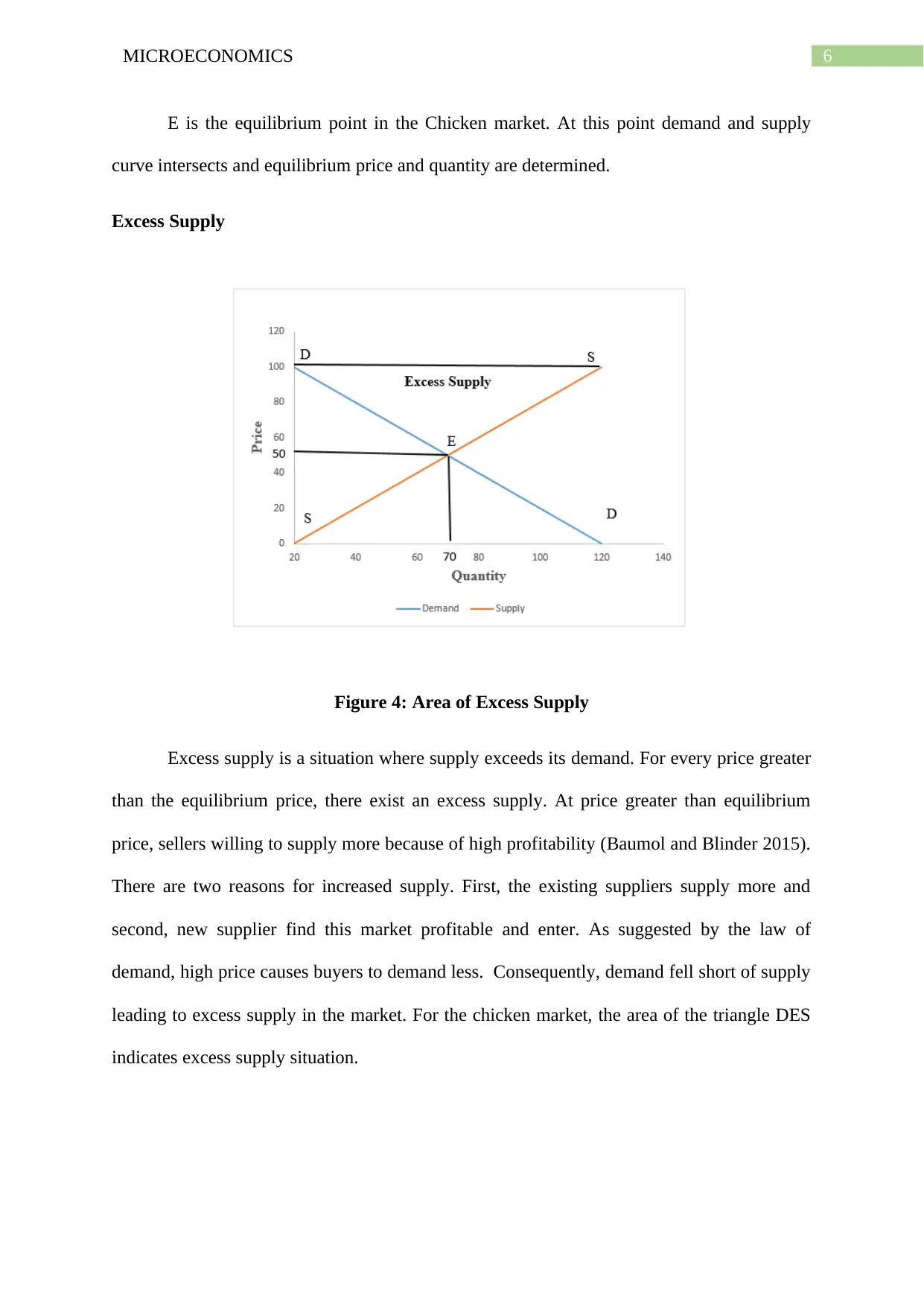
6MICROECONOMICS
E is the equilibrium point in the Chicken market. At this point demand and supply
curve intersects and equilibrium price and quantity are determined.
Excess Supply
Figure 4: Area of Excess Supply
Excess supply is a situation where supply exceeds its demand. For every price greater
than the equilibrium price, there exist an excess supply. At price greater than equilibrium
price, sellers willing to supply more because of high profitability (Baumol and Blinder 2015).
There are two reasons for increased supply. First, the existing suppliers supply more and
second, new supplier find this market profitable and enter. As suggested by the law of
demand, high price causes buyers to demand less. Consequently, demand fell short of supply
leading to excess supply in the market. For the chicken market, the area of the triangle DES
indicates excess supply situation.
E is the equilibrium point in the Chicken market. At this point demand and supply
curve intersects and equilibrium price and quantity are determined.
Excess Supply
Figure 4: Area of Excess Supply
Excess supply is a situation where supply exceeds its demand. For every price greater
than the equilibrium price, there exist an excess supply. At price greater than equilibrium
price, sellers willing to supply more because of high profitability (Baumol and Blinder 2015).
There are two reasons for increased supply. First, the existing suppliers supply more and
second, new supplier find this market profitable and enter. As suggested by the law of
demand, high price causes buyers to demand less. Consequently, demand fell short of supply
leading to excess supply in the market. For the chicken market, the area of the triangle DES
indicates excess supply situation.
Paraphrase This Document
Need a fresh take? Get an instant paraphrase of this document with our AI Paraphraser
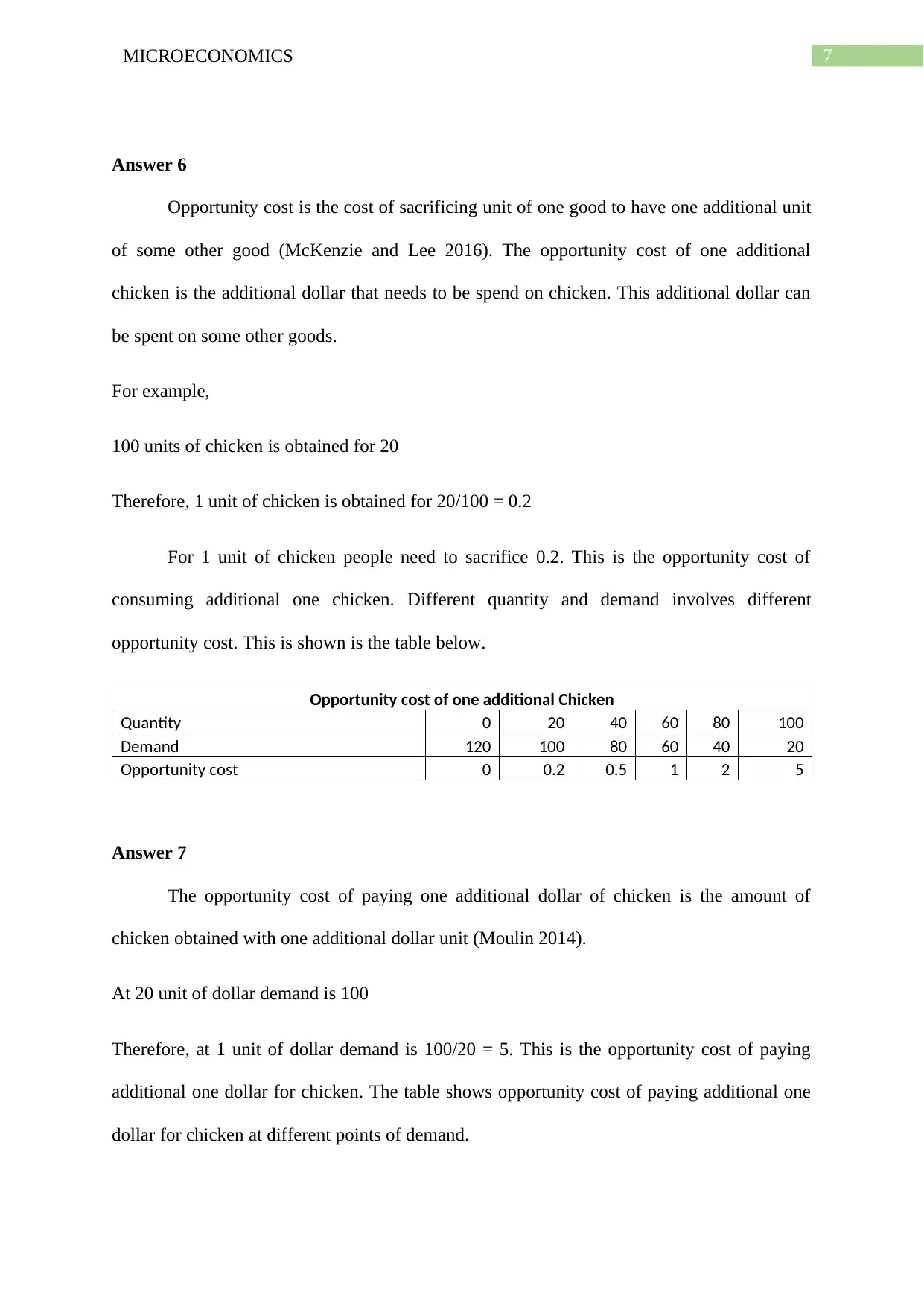
7MICROECONOMICS
Answer 6
Opportunity cost is the cost of sacrificing unit of one good to have one additional unit
of some other good (McKenzie and Lee 2016). The opportunity cost of one additional
chicken is the additional dollar that needs to be spend on chicken. This additional dollar can
be spent on some other goods.
For example,
100 units of chicken is obtained for 20
Therefore, 1 unit of chicken is obtained for 20/100 = 0.2
For 1 unit of chicken people need to sacrifice 0.2. This is the opportunity cost of
consuming additional one chicken. Different quantity and demand involves different
opportunity cost. This is shown is the table below.
Opportunity cost of one additional Chicken
Quantity 0 20 40 60 80 100
Demand 120 100 80 60 40 20
Opportunity cost 0 0.2 0.5 1 2 5
Answer 7
The opportunity cost of paying one additional dollar of chicken is the amount of
chicken obtained with one additional dollar unit (Moulin 2014).
At 20 unit of dollar demand is 100
Therefore, at 1 unit of dollar demand is 100/20 = 5. This is the opportunity cost of paying
additional one dollar for chicken. The table shows opportunity cost of paying additional one
dollar for chicken at different points of demand.
Answer 6
Opportunity cost is the cost of sacrificing unit of one good to have one additional unit
of some other good (McKenzie and Lee 2016). The opportunity cost of one additional
chicken is the additional dollar that needs to be spend on chicken. This additional dollar can
be spent on some other goods.
For example,
100 units of chicken is obtained for 20
Therefore, 1 unit of chicken is obtained for 20/100 = 0.2
For 1 unit of chicken people need to sacrifice 0.2. This is the opportunity cost of
consuming additional one chicken. Different quantity and demand involves different
opportunity cost. This is shown is the table below.
Opportunity cost of one additional Chicken
Quantity 0 20 40 60 80 100
Demand 120 100 80 60 40 20
Opportunity cost 0 0.2 0.5 1 2 5
Answer 7
The opportunity cost of paying one additional dollar of chicken is the amount of
chicken obtained with one additional dollar unit (Moulin 2014).
At 20 unit of dollar demand is 100
Therefore, at 1 unit of dollar demand is 100/20 = 5. This is the opportunity cost of paying
additional one dollar for chicken. The table shows opportunity cost of paying additional one
dollar for chicken at different points of demand.
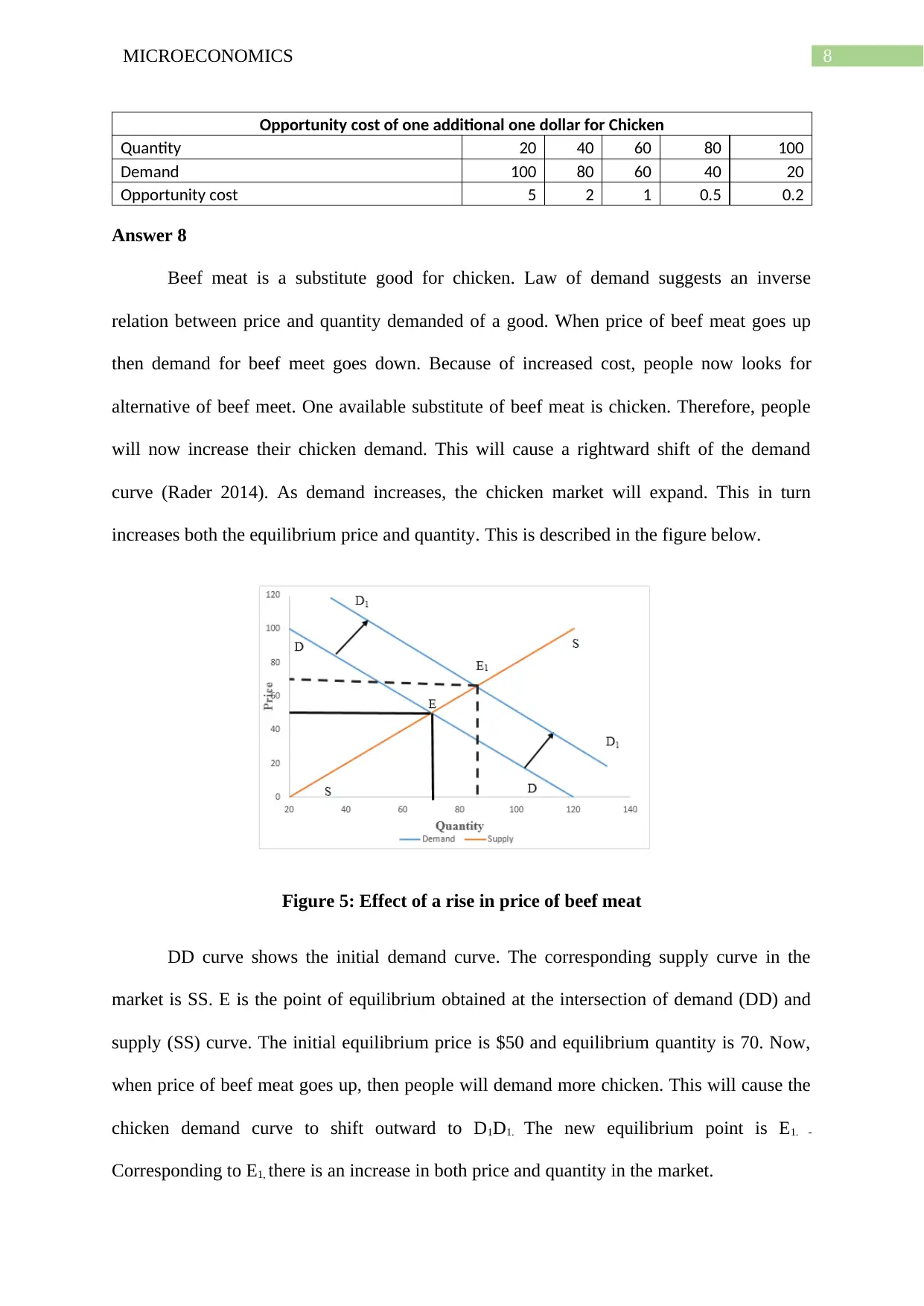
8MICROECONOMICS
Opportunity cost of one additional one dollar for Chicken
Quantity 20 40 60 80 100
Demand 100 80 60 40 20
Opportunity cost 5 2 1 0.5 0.2
Answer 8
Beef meat is a substitute good for chicken. Law of demand suggests an inverse
relation between price and quantity demanded of a good. When price of beef meat goes up
then demand for beef meet goes down. Because of increased cost, people now looks for
alternative of beef meet. One available substitute of beef meat is chicken. Therefore, people
will now increase their chicken demand. This will cause a rightward shift of the demand
curve (Rader 2014). As demand increases, the chicken market will expand. This in turn
increases both the equilibrium price and quantity. This is described in the figure below.
Figure 5: Effect of a rise in price of beef meat
DD curve shows the initial demand curve. The corresponding supply curve in the
market is SS. E is the point of equilibrium obtained at the intersection of demand (DD) and
supply (SS) curve. The initial equilibrium price is $50 and equilibrium quantity is 70. Now,
when price of beef meat goes up, then people will demand more chicken. This will cause the
chicken demand curve to shift outward to D1D1. The new equilibrium point is E1. -
Corresponding to E1, there is an increase in both price and quantity in the market.
Opportunity cost of one additional one dollar for Chicken
Quantity 20 40 60 80 100
Demand 100 80 60 40 20
Opportunity cost 5 2 1 0.5 0.2
Answer 8
Beef meat is a substitute good for chicken. Law of demand suggests an inverse
relation between price and quantity demanded of a good. When price of beef meat goes up
then demand for beef meet goes down. Because of increased cost, people now looks for
alternative of beef meet. One available substitute of beef meat is chicken. Therefore, people
will now increase their chicken demand. This will cause a rightward shift of the demand
curve (Rader 2014). As demand increases, the chicken market will expand. This in turn
increases both the equilibrium price and quantity. This is described in the figure below.
Figure 5: Effect of a rise in price of beef meat
DD curve shows the initial demand curve. The corresponding supply curve in the
market is SS. E is the point of equilibrium obtained at the intersection of demand (DD) and
supply (SS) curve. The initial equilibrium price is $50 and equilibrium quantity is 70. Now,
when price of beef meat goes up, then people will demand more chicken. This will cause the
chicken demand curve to shift outward to D1D1. The new equilibrium point is E1. -
Corresponding to E1, there is an increase in both price and quantity in the market.
⊘ This is a preview!⊘
Do you want full access?
Subscribe today to unlock all pages.

Trusted by 1+ million students worldwide
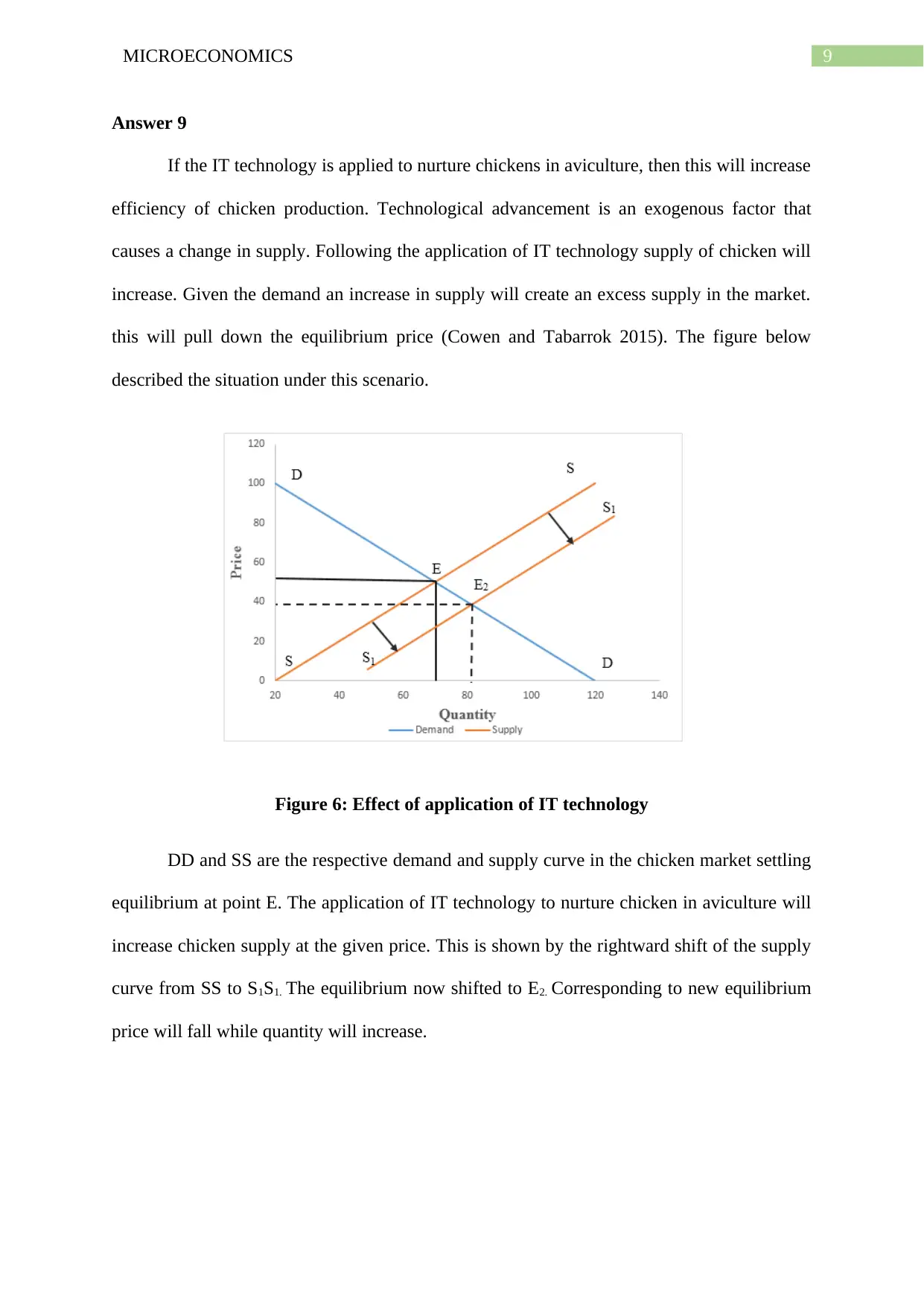
9MICROECONOMICS
Answer 9
If the IT technology is applied to nurture chickens in aviculture, then this will increase
efficiency of chicken production. Technological advancement is an exogenous factor that
causes a change in supply. Following the application of IT technology supply of chicken will
increase. Given the demand an increase in supply will create an excess supply in the market.
this will pull down the equilibrium price (Cowen and Tabarrok 2015). The figure below
described the situation under this scenario.
Figure 6: Effect of application of IT technology
DD and SS are the respective demand and supply curve in the chicken market settling
equilibrium at point E. The application of IT technology to nurture chicken in aviculture will
increase chicken supply at the given price. This is shown by the rightward shift of the supply
curve from SS to S1S1. The equilibrium now shifted to E2. Corresponding to new equilibrium
price will fall while quantity will increase.
Answer 9
If the IT technology is applied to nurture chickens in aviculture, then this will increase
efficiency of chicken production. Technological advancement is an exogenous factor that
causes a change in supply. Following the application of IT technology supply of chicken will
increase. Given the demand an increase in supply will create an excess supply in the market.
this will pull down the equilibrium price (Cowen and Tabarrok 2015). The figure below
described the situation under this scenario.
Figure 6: Effect of application of IT technology
DD and SS are the respective demand and supply curve in the chicken market settling
equilibrium at point E. The application of IT technology to nurture chicken in aviculture will
increase chicken supply at the given price. This is shown by the rightward shift of the supply
curve from SS to S1S1. The equilibrium now shifted to E2. Corresponding to new equilibrium
price will fall while quantity will increase.
Paraphrase This Document
Need a fresh take? Get an instant paraphrase of this document with our AI Paraphraser
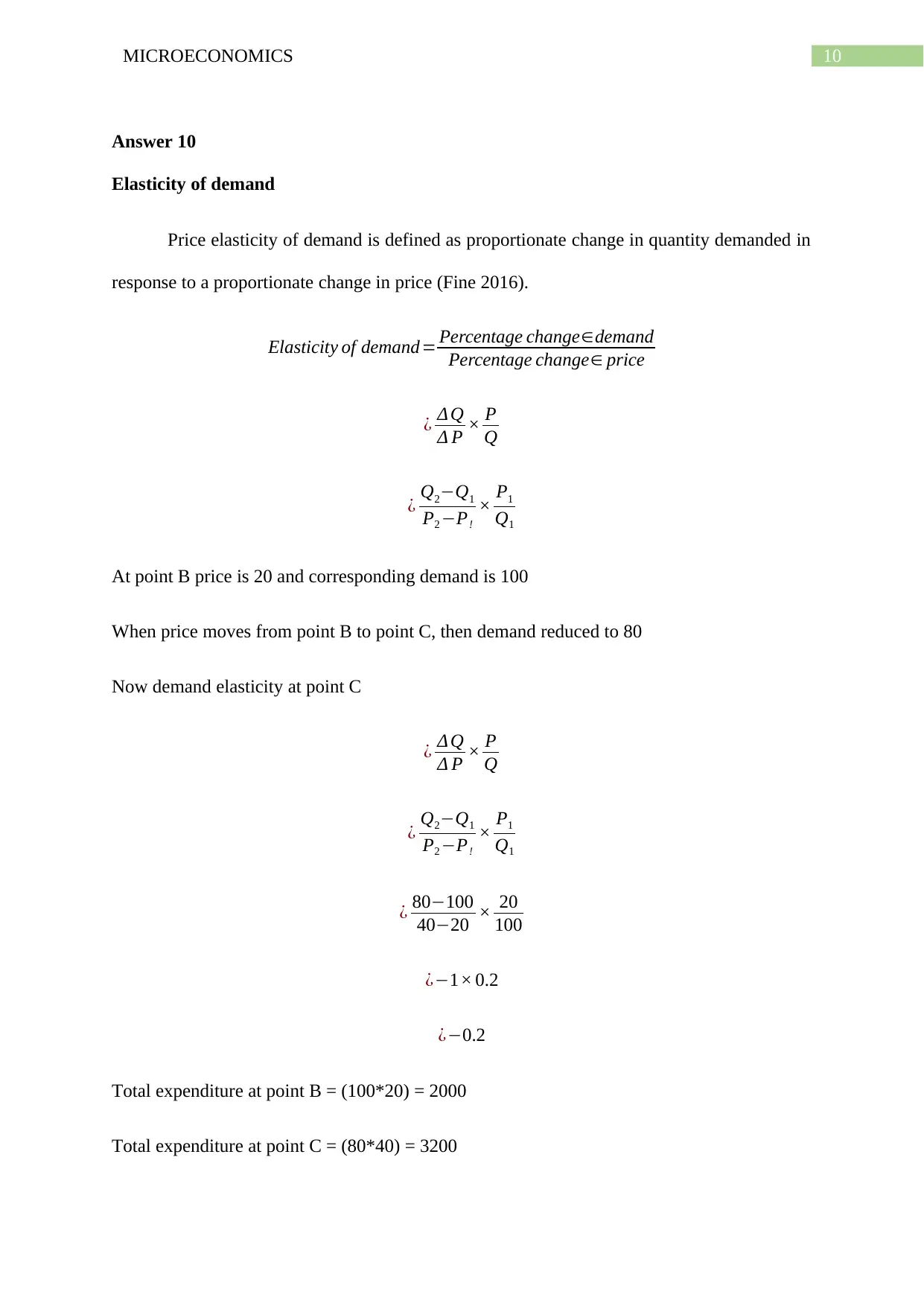
10MICROECONOMICS
Answer 10
Elasticity of demand
Price elasticity of demand is defined as proportionate change in quantity demanded in
response to a proportionate change in price (Fine 2016).
Elasticity of demand= Percentage change∈demand
Percentage change∈ price
¿ Δ Q
Δ P × P
Q
¿ Q2−Q1
P2 −P!
× P1
Q1
At point B price is 20 and corresponding demand is 100
When price moves from point B to point C, then demand reduced to 80
Now demand elasticity at point C
¿ Δ Q
Δ P × P
Q
¿ Q2−Q1
P2 −P!
× P1
Q1
¿ 80−100
40−20 × 20
100
¿−1× 0.2
¿−0.2
Total expenditure at point B = (100*20) = 2000
Total expenditure at point C = (80*40) = 3200
Answer 10
Elasticity of demand
Price elasticity of demand is defined as proportionate change in quantity demanded in
response to a proportionate change in price (Fine 2016).
Elasticity of demand= Percentage change∈demand
Percentage change∈ price
¿ Δ Q
Δ P × P
Q
¿ Q2−Q1
P2 −P!
× P1
Q1
At point B price is 20 and corresponding demand is 100
When price moves from point B to point C, then demand reduced to 80
Now demand elasticity at point C
¿ Δ Q
Δ P × P
Q
¿ Q2−Q1
P2 −P!
× P1
Q1
¿ 80−100
40−20 × 20
100
¿−1× 0.2
¿−0.2
Total expenditure at point B = (100*20) = 2000
Total expenditure at point C = (80*40) = 3200
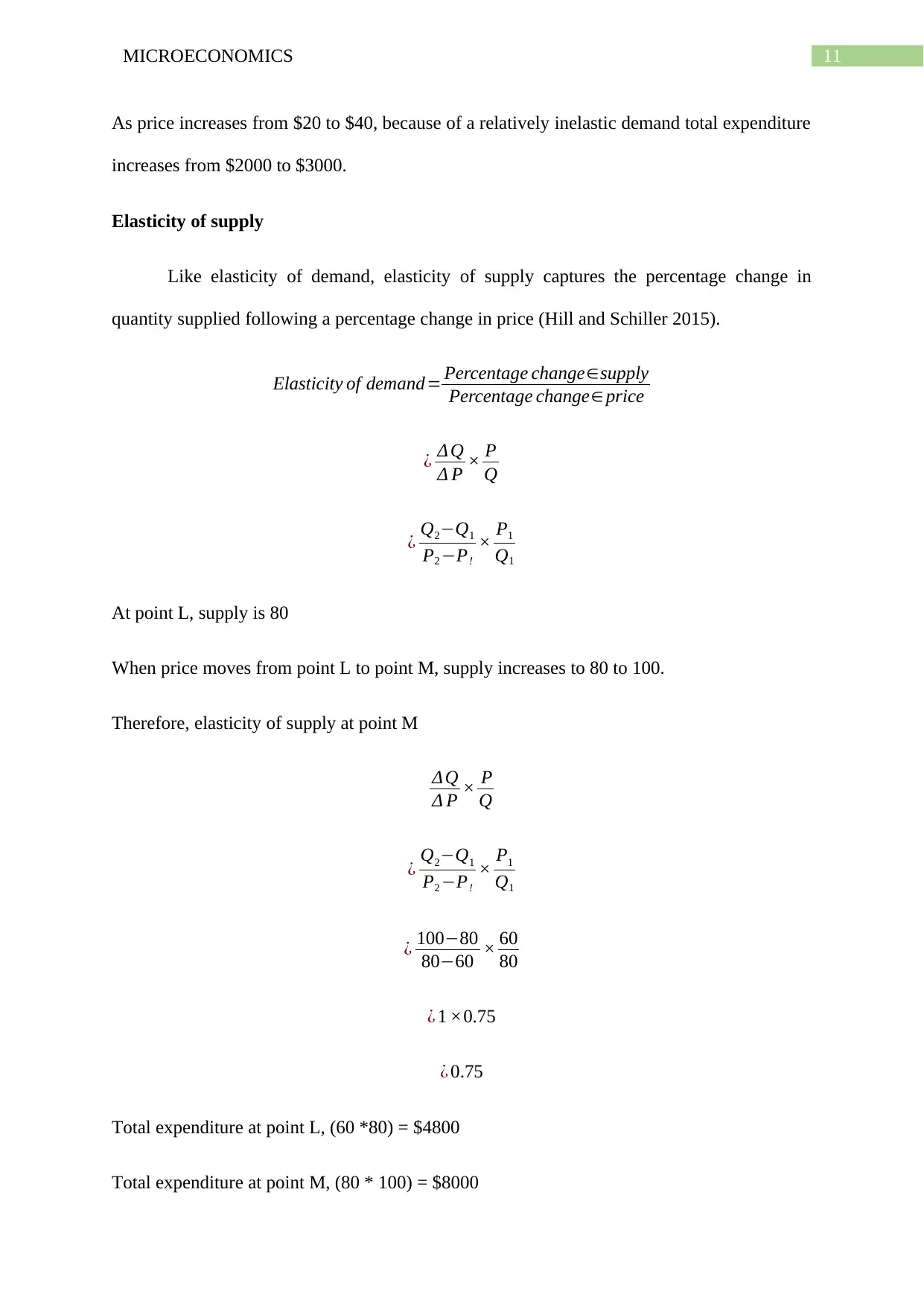
11MICROECONOMICS
As price increases from $20 to $40, because of a relatively inelastic demand total expenditure
increases from $2000 to $3000.
Elasticity of supply
Like elasticity of demand, elasticity of supply captures the percentage change in
quantity supplied following a percentage change in price (Hill and Schiller 2015).
Elasticity of demand= Percentage change∈supply
Percentage change∈ price
¿ Δ Q
Δ P × P
Q
¿ Q2−Q1
P2 −P!
× P1
Q1
At point L, supply is 80
When price moves from point L to point M, supply increases to 80 to 100.
Therefore, elasticity of supply at point M
Δ Q
Δ P × P
Q
¿ Q2−Q1
P2 −P!
× P1
Q1
¿ 100−80
80−60 × 60
80
¿ 1 ×0.75
¿ 0.75
Total expenditure at point L, (60 *80) = $4800
Total expenditure at point M, (80 * 100) = $8000
As price increases from $20 to $40, because of a relatively inelastic demand total expenditure
increases from $2000 to $3000.
Elasticity of supply
Like elasticity of demand, elasticity of supply captures the percentage change in
quantity supplied following a percentage change in price (Hill and Schiller 2015).
Elasticity of demand= Percentage change∈supply
Percentage change∈ price
¿ Δ Q
Δ P × P
Q
¿ Q2−Q1
P2 −P!
× P1
Q1
At point L, supply is 80
When price moves from point L to point M, supply increases to 80 to 100.
Therefore, elasticity of supply at point M
Δ Q
Δ P × P
Q
¿ Q2−Q1
P2 −P!
× P1
Q1
¿ 100−80
80−60 × 60
80
¿ 1 ×0.75
¿ 0.75
Total expenditure at point L, (60 *80) = $4800
Total expenditure at point M, (80 * 100) = $8000
⊘ This is a preview!⊘
Do you want full access?
Subscribe today to unlock all pages.

Trusted by 1+ million students worldwide
1 out of 16
Related Documents
Your All-in-One AI-Powered Toolkit for Academic Success.
+13062052269
info@desklib.com
Available 24*7 on WhatsApp / Email
![[object Object]](/_next/static/media/star-bottom.7253800d.svg)
Unlock your academic potential
Copyright © 2020–2025 A2Z Services. All Rights Reserved. Developed and managed by ZUCOL.





